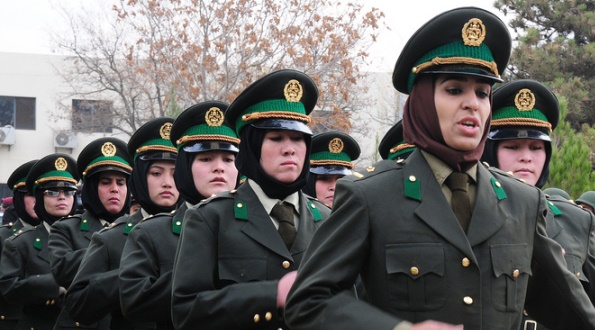BECOME A MEMBER
>JOIN
Supporting Afghan Female Soldiers

Fifty-three billion and change. That’s how much the U.S. has spent to build, train, equip, and sustain the Afghan National Security Forces. Still, this support hasn’t resulted in a military that is inclusive, representative, or capable of addressing the security needs of all Afghans—men and women alike.
On Thursday, Congress took an unprecedented step to ensure women’s meaningful participation in the stability and democratization of their nation. In passing the 52nd National Defense Authorization Act, they authorized funds specifically for women in the Afghan forces, designating a minimum of $25 million to bolster their ranks. With women comprising only one percent of the Afghan National Police and 0.3 percent of the Afghan National Army, the consequences of not doing so would be dire.
Without female security officers, Afghan women will not be allowed to vote. Most voter registration and polling stations are sex-segregated. Female security personnel are needed to staff women-only polling stations, which remain closed if there are no women to fill the role. There’s a lot riding on the April 2014 presidential election—not least, protections for women’s rights. The best way to maintain the hard-earned gains of Afghan women is to elect a president who will uphold them. And the best way to elect a president of that profile is to enable women to vote.
To effectively counter terrorism and violent extremism, there must be women in the police and military. Last year in Afghanistan, there were at least 13 recorded accounts of male insurgents dressed as women entering restricted areas from which they launched attacks. There were no female body searchers to stop them. Beyond circumventing targeted attacks, women expand the capability of security forces to engage populations affected by insecurity and natural disasters. Expanded engagement means better collection of information and stronger understanding of context, which ultimately results in more effective operations.
"Female security personnel are needed to staff women-only polling stations, which remain closed if there are no women to fill the role."
The overall goal is to establish national forces that can provide security for all Afghans—inclusive of men, women, boys, and girls. To realize this goal, security forces must equally address the security threats experienced by each of these groups. Consider, for example, sexual and gender-based violence targeting women. As many as 87 percent of Afghan women experience domestic violence or forced marriage in their lifetime. Women are more likely to report these crimes to female police officers, who are more likely than male officers to register and investigate the offenses.
It took the better part of a decade, but Congress has finally undertaken legislative action to increase support for women who want to serve in the Afghan National Security Forces. In addition to the NDAA, both the House and Senate defense appropriations bills have similar provisions addressing women’s recruitment and retention. Senators have sent letters to military officials on the subject and civil society groups have signed statements of support with the shared objective of reducing institutional barriers to women’s participation in the forces and increasing the recruitment of women as a result.
The U.S. is struggling with President Karzai to finalize the Bilateral Security Agreement. And the future of the U.S. military presence in Afghanistan remains unclear. But this week, Congress gave us cause for hope. For women’s security to be assured, protections for women’s rights upheld, and the political transition to be inclusive of all Afghans, women must participate in the political and security institutions mandated to safeguard progress. Billions later, Congress is finally realizing that peace and stability are, in fact, contingent on it.
By Michelle Barsa. Michelle Barsa is Senior Manager for Policy at Inclusive Security Action where she focuses on expanding the role for women in Afghanistan’s peace and security processes. Michelle recently testified before Congress on the subject of women in the Afghan National Security Forces, based on her work with women in Afghan National Police and Afghan National Army.
Originally published on TheDailyBest.com.
Photo by NATO Training Mission-Afghanistan.

